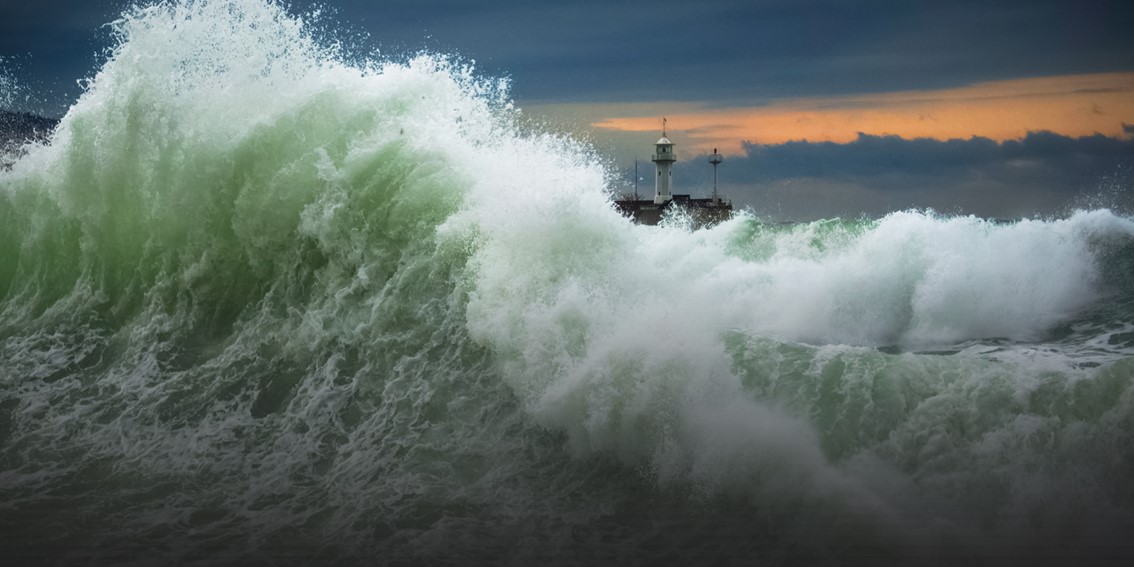
With the first Hurricane Milton Post-Event Report detailing the storm’s superlatives, impacts and performance relative to forecasts, this second Post-Event Report will delve into current loss estimates and the avoidance of a worst-case scenario. In addition, this discussion will analyze Hurricane Milton through the lens of climate change and compare the back-to-back impacts of Hurricanes Milton and Helene to historical years with consecutive major hurricane landfalls in Florida, such as 2004.
Post-Event Report: Hurricane Milton Report - Part 2
Insured Loss Estimates

Worst Surge Scenario Averted
Ultimately, the impacts of Milton in the Tampa Bay and Sarasota metropolitan areas were damaging, but larger loss scenarios were avoided. In the days leading up to landfall, several deterministic hurricane models depicted Milton making landfall to the north of the mouth of Tampa Bay. Even 36 hours before Milton’s landfall, the National Hurricane Center’s forecast cone for Milton depicted a landfall in Pinellas County because many regional dynamical models indicated a potential landfall further north than what ultimately transpired.
Milton’s counterclockwise winds swirling around its center of circulation coupled with its northeastward motion resulted in the maximum storm surge to the southeast of the storm’s landfall point. The landfall forecasts just north of Tampa Bay would have likely caused 10-15 feet of destructive storm surge into major city centers such as St. Petersburg and Tampa. Such a scenario would have inundated large portions of the urban area and caused catastrophic flooding, well in excess of the record high levels seen in Helene the week before. Fortunately for the industry, an extreme disaster scenario was averted as Milton’s landfall in Sarasota County to the south mitigated storm surge in Tampa Bay.
As seen in Ian and Irma, northeasterly winds in the storm’s northern eyewall pushed water out of the Bay in a “reverse surge.” Destructive storm surge did materialize south of Milton’s eye, though peak impacts were centered on smaller communities in Sarasota and Charlotte County. Milton was still a significant water event across Tampa Bay, as record-setting rainfall transpired in Pinellas and Hillsborough County.

Hurricane Milton Timeline

The Case of Two Power Outages
The chart below highlights a selection of impactful landfalling hurricane power outages since 2017, along with the Texas freeze from 2021. Helene and Milton peaked at nearly the same number of customer outages at 3.3 to 3.4 million.
Thereafter, restoration in Milton was the most rapid in the hurricanes analyzed and second most rapid restoration behind the Texas freeze. Power grid resiliency through installation of underground lines in critical infrastructure areas, hardening coastal community assets, proactive tree trimming, and pre-positioning recovery assets helped rapid restoration in Milton.
For Helene, destroyed infrastructure and lack of ingress/egress resulted in Helene having the highest number of outages after 7 days of any event surveyed.

Climate Change and Hurricane Milton
Increasing Frequency of Major Hurricanes
On the evening of October 8, Hurricane Milton became the second Category 5 hurricane of 2024 and 23rd in the North Atlantic between 1980-2024. In the first 23 years of this 45-year period, there were only 5 Category 5 hurricanes recorded; in the second 22 years, there were 18.
Based on pressure (897 mb), Milton was the fifth-most-intense hurricane in the Atlantic basin on record. Milton represents yet another example of the growing climate signal that once a tropical cyclone forms, it has a higher probability of becoming stronger (discussed in a 2024 Guy Carpenter white paper).


Ocean temperatures were consistently more than 1°C warmer than average along Milton’s track. As a result, Milton jumped from a Category 1 to a Category 5 hurricane in 18 hours and tied Hurricane Wilma for the fastest 36-hour intensification period in the North Atlantic historical record, intensifying by 120 mph in 36 hours.
Climate change is increasing the odds of wetter (from storm surge and rainfall) and stronger hurricanes, which raises the potential for higher financial losses for the insurance industry.
Back-to-Back Landfalls
Milton and Helene
Hurricane Milton’s landfall near Siesta Key, Florida, came just 13 calendar days after Hurricane Helene’s landfall along the Big Bend region in Florida. While the direct landfall locations were roughly 200 miles apart, a large swath of Florida from Tampa to Jacksonville, extending across the state, experienced wind impacts from both storms. In both events, heavy rainfall events in the days before landfall enabled strong tropical storm force winds to blow over trees and powerlines, which increased property damage. Along the west coast of Florida, an estimated 50% of remnant debris from storm surge and flood impacts from Helene were cleaned up prior to landfall, likely a source of additional loss in Milton.
Event Clustering
There are only few examples during the satellite era where Florida experienced multiple major hurricanes making landfall in the same season. In 2004, Hurricanes Charley and Jeanne made landfall on opposite sides of the Florida peninsula, and another major hurricane, Ivan, made landfall just to the west, near Gulf Shores, Alabama. In the record-breaking 2005 hurricane season, Florida again saw two major hurricane landfalls with Dennis and Wilma. Back-to-back events are a challenge to properly ascribe loss to each storm. Also, attributing losses to wind or water as the cause of loss will be more complex than normal.
A Place in History
Historically, only 5 other major hurricanes on record have made landfall in the region between Milton and Helene’s landfalls: Idalia (2023), Easy (1950), and 3 unnamed storms in 1935, 1921, and 1896. Notably, Charley (2004) and Ian (2022) made landfall less than 80 miles south of where Milton’s eye came ashore, and Irma (2017) roughly 120 miles south. One benefit of storms in recent years making landfall near Helene and Milton is better roof performance. Early signs assessing damage from Milton show that roofs replaced following hurricanes occurring within the last 10 years performed better than older construction, while older storms such as Charley and the resulting more stringent building codes continue to be a major source of loss reduction.
